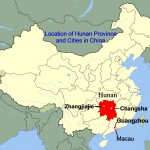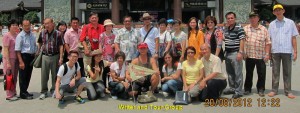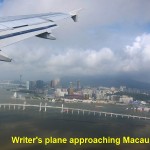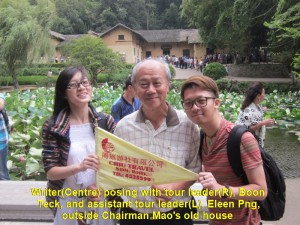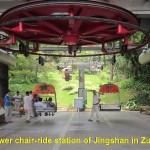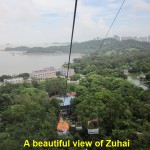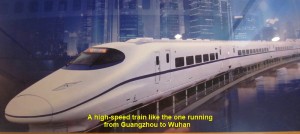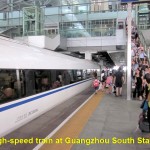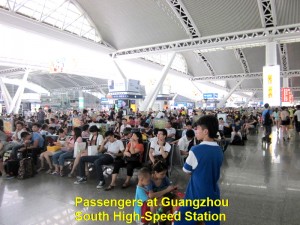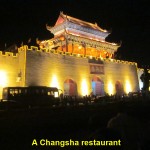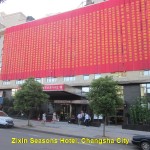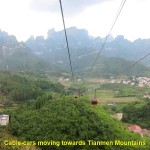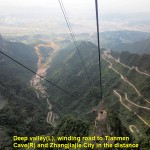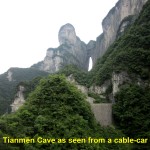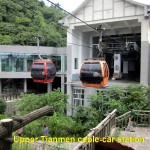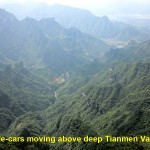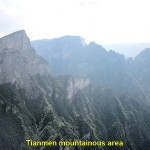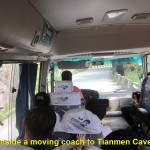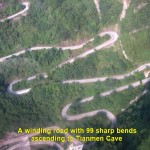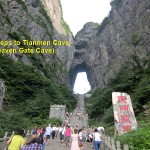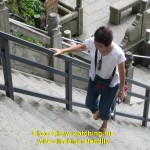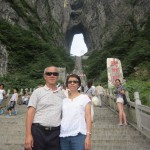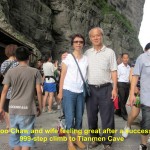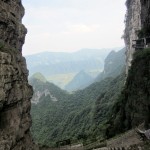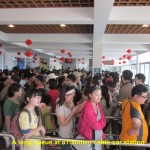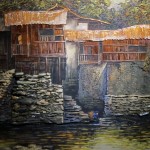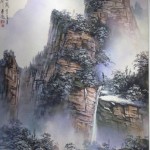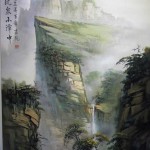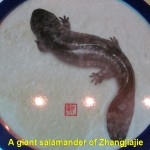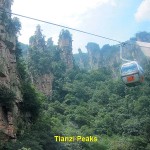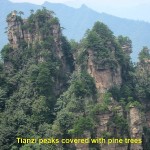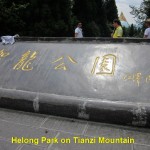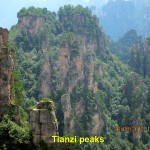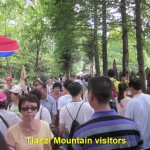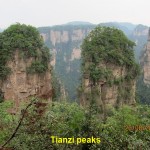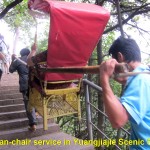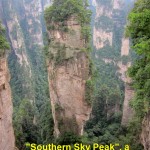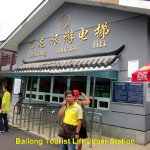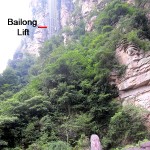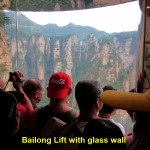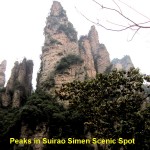Zhangjiajie Travel I
Zhangjiajie Travel I
Introduction
Zhangjiajie is a land of many spectacular and stunning natural scenic spots in Hunan Province of China. Every year, millions of tourists from all over China and the world flock to the place to see and be mesmerized by its beautiful, unique, natural karst landscapes.
Chiu Travel Sdn. Bhd.
As a travel agency in Batu Pahat, Chiu Travel Sdn. Berhad, strongly recommended an 8 Day 6 Night tour to Zhangjiajie, including a visit to two cities, Macau and Changsha, to my wife and me, we gladly booked with it the tour from 17 August 2012 until 24 August 2012.
Day 1 Saturday, 18 August 2012
Typhoon Kai-Tak
On Friday, 17 August 2012, we were ready to go for the much anticipated tour. But we were disappointed when we were told by the travel agency that the flight from Singapore to Macau was delayed for a day due to a strong wind, Typhoon Kai-Tak, that was blowing from South China Sea to South China soon.
Tour Leader, Boon Teck
A day later, Saturday, 18 August 2012, when the storm was over, my wife and I were brought to Singapore Changi International Airport together with some Malaysian tourists by the agency’s bus. Our tour leader was a young, energetic man, Boon Teck, and his pretty assistant Eeling Png.
Departure to Macau
At 5.45 in the morning, after a delay of two hours, we, finally, flew to Macau by Air Macau. The air-journey took about 3½ hours without any storm-problem. After landing, safely, at the Macau International Airport, we went through 3 immigration check-points before we reached Zuhai city in Guangdong Province in Mainland China at 11.30 am. That was quite a hassle going through the check-points with our heavy luggage. Besides, the check-points were crowded with visitors.
Jingshan, Zuhai
When we were outside the Zuhai immigration check-point, a tour guide, Yang, greeted us and asked us to board a tour bus driven by Lee. Lee, immediately,brought us to a restaurant for lunch. After lunch, we went to the highest hill in Zuhai, Jingshan(Scenic Hill), which is over 100 metres above sea-level. We went up the hill by cable-chairs. Standing on top of it, we saw panoramic views of a Zuhai bay and the city with many multi-storey residential buildings. Then we left the hill at 1.30 p.m. and travelled north to Guangzhou City, a distance of 126 km. At 3.10 p.m., we arrived at the Guangzhou South Railway Station
Guangzhou South Railway Station
Opened on 30 January 2011, Guangzhou South Railway Station is one of the four largest and busiest railway stations in China. It looks like a large, modern airport terminal from a distance. High-speed trains travel from the station to Wuhan City in the north in Hubei Province, a distance of 968 km and the travelling time is 3½ hours
Since 28 August 2011, the maximum speed of these trains was reduced from 350 to 300 km/h following the Wenzhou two-train collision that killed 40 and injured 192 people on 23 July 2011 in Zhejiang Province.
Travellers’ Choice
Nowadays, most of the people who travel short distances in China prefer to travel on high-speed trains. Although aeroplanes fly at higher speeds than trains, the former need more time to taxi, wait for passengers to board(each plane opens a door for passengers to enter), load luggage, check their engines and wait for their turns to take off. Furthermore, airports are located further away from city centres than railway stations, and they require passengers to check-in one or two hours before they fly off. For these reasons, many short-distance travellers in China prefer to go by high-speed trains.
On arrival at the Guangzhou South Railway Station, we were surprised to see many travellers there. Before we entered the waiting area at the station, our bags were screened by a machine and watched by security guards.
When the train arrived at 4.00 p.m., we were allowed to enter the station-platform and board the train coaches according to the coach-numbers and the seat-numbers that were printed on our tickets.
High-Speed Train Ride
At 4.15 p.m., our train pulled out of the station slowly and then moved fast to Changsha Railway Station which is over 700 km away in Hunan Province. On the way, it passed through towns, cities, farmlands and tunnels. It stopped at two cities for passengers to get off and on.
During the journey, I noticed that the train reached the maximum speed of 308 km/h a few times. After 2 hours and 50 mins on the train, we, finally, reached Changsha Railway Station at 7.05 p.m.. We were glad that it was a smooth and comfortable ride without any feeling of the speed.
Zhangjiajie Tour Guide
At the Changsha Railway Station, a Zhangjiajie tour guide greeted us and introduced himself as Ah Chen. We followed him outside the station and boarded a tour bus driven by Cho. Cho brought us to a downtown restaurant for dinner and then to a hotel, Zixin Hotel(Four Seasons Hotel) in Changsha City centre. As we had all spent the whole day travelling, we felt very tired, and retired early at the hotel.
Day 2 Sunday 19 August 2012
Tianmen Mountain, Zhanjiajie
At 8.10 in the morning, we left Changsha City for another long journey by bus. This time we headed north-west to Zhanjiajie City. On arrival at 12.50 p.m., we had lunch at a restaurant. Then we went to a cable-car station in the city, stepped into cable-cars and travelled 7.455 km to a famous mountain known as Tianmen Mountain(Heaven Gate Mountain) which is over 1,450 m above sea-level. The cableway is the longest one in high mountains in the world. It ascends 1,279 metres and climbs the greatest gradient of 37°. It was built by a French company, Poma.
Tianmen Cable-Car Ride
The cable-car ride gave us a wonderful experience. While we were ascending towards the middle station and then the upper one, we could see the landscape changing from the urban lowland to the dense-forested mountainous highland. Midway, we saw on our left a high hole through Tianmen Mountain known as Tianmen Dong(Tianmen Cave) in the distance, and a long, winding road that snaked its way up to the cave.
Tianmen Glass-Walkway
Over 40 minutes later, we arrived at the upper station on top of Tianmen Mountain. We all got out of the station and walked to the west side of the mountain. Then we rented a pair of cloth-shoe covers, put them over our shoes and walked on a glass-walkway built onto a sheer cliff, known as Ghost Cliff(Guigu Cliff). The shoe covers were worn to prevent the glass-walkway from being scratched.
The transparent walkway or “Tianmen Skywalk” is part of the long, narrow trail round the mountain. It is 60 metres long and 1,450 metres above sea-level. That high see-through walkway is not for the faint-hearted who have phobia for heights(acrophobia). I noticed that one of our tour-members felt dizzy as she was walking on it, unsteadily
Breathtaking Views
While we were standing on the walkway and holding onto its railing, we saw panoramic and breathtaking views of the dense-forested mountains, deep valleys below, a small airport and Zhangjiajie city in the distance. Then we continued walking and looking at more beautiful natural sceneries. Soon, we returned to the upper cable-car station. From the station, we got into cable-cars again and moved down to the middle station. Coming out of the middle station, we took shuttle-coaches to another part of Tianmen Mountain known as Tianmen Dong(Heavenly Gate Cave) which we saw earlier.
Tianmen Winding Road
Our coach ascended, noisily, a long, winding, narrow 11 km road with 99 sharp bends to the cave. There were steep slopes soaring high on one side of the road and steep slopes going down on the other side. But our skilful and amazing coach-driver sped all the way up to the cave, effortlessly, in 20 minutes.
Tianmen Cave
We felt relieved, when we reached, safely, the bottom of the cave which was over 1000 metres above sea-level. Standing at the bottom, we looked up and was awe-stricken to see a large hole that went through the eastern part of the Tianmen Mountain. It is known as Tianmen Cave(Tianmen Dong).
Tianmen Cave Events
This cave has been well-known worldwide for many years because of some events that have taken place there. In 1999, a team of 15 stunt pilots from around the world flew their old-fashioned mono-planes through the cave several times for a fund-raising cause. In 2006, a team of Russian pilots in small fighter-jets flew through it for a special televised fund-raising show.
Alain Robert, “Spider-Man”
In 2007, Alain Robert, a skilful climber from France and popularly known as “Spider-Man”, was invited by Zhangjiajie local government to climb up the steep wall of the cave. He did it with bare-hands and without any safety harness. He climbed 200 metres to the top in 40 minutes. All these events have boosted the profile of Tianmen Cave.
A Climb of 999 Steps
To reach the cave, visitors have to climb 999 steps. That is a lot of steps to climb, and besides, a few staircases are steep. My wife and I took it as a challenge, although we were over 60.
At first, it was easy to climb up many steps. Later, we felt our legs were getting heavy and had to stop for awhile. Then we climbed again and stopped again. We did that a few times and had never thought of giving up. As we climbed up, we watched young and old people climbing up too. We noticed that some were struggling after climbing half-way.
A Worthwhile Effort
Soon, we reached the cave we felt a great sense of achievement to have climbed up so many steps. From the cave, as we could see below and in front of us breathtaking sights of natural landscapes, people going up and down the steps and the treacherous road that snaked its way up to the cave. Furthermore, behind the cave, we could see dense-forested mountains and lush valleys
The cave is like a short tunnel of 60 metres deep. It has a shape of a trapezium with a height of 130 metres and 60 metres wide at its base. Standing in the cave and looking up, I could imagine small planes and fighter-jets flying through it several times, and Alain Robert or “Spider-Man” climbing up the sheer cave wall with his bare hands.
Return to Zhangjiajie City
Having seen enough of the beautiful sceneries from the cave, we went down the steps, slowly and carefully. We could not afford to make any false step, otherwise, we would tumble all the way down to the bottom and land ourselves in a hospital. When we reached the bottom of the steps, we took a shuttle-coach again and returned to the middle cable-car station.
At the crowded station, we had to queue up for several minutes. Then we got into cable-cars and went down to the lower station in Zhangjiajie City. At 6.30 p.m. we reached the station and went to a downtown restaurant for an early dinner, as we were going to watch a live performance known as “Tianmen Fox Fairy Tale” in a large open-air theatre in a grand valley of Tianmen Mountain.
After the meal, we went straight to the theatre. In the theatre, we were surprised to see lots of people and amazed to see a large stage that had Tujia ethnic minority mountain houses built on the left, large tree-trunks in the middle, terraces on the mountain slope on the right, and towering mountains in the background.
Before the show started, a short auction of large and long Chinese paintings was carried out on the stage. Surprisingly, all the auctioned paintings were snapped up.
“Tianmen Fox Fairy Tale” Performance
At 8.30 p.m. sharp the show began. It was about a fox fairy, an immortal, falling in love with a poor farmer, a mortal, in a Tujia village. The story originated from a local folk-tale. It was depicted in a musical drama performance involving a cast of over 500 performers in traditional costumes. Hundreds of people, each paying RMB 400, packed the theatre to watch the performance. The show was long and lasted for 2½ hours. It ended with the man and the lady married, had a family and lived together, happily. That story is quite different from the Romeo and Juliet’s, as the two poor lovers died in the end.
We left the theatre, immediately, after the performance, and went straight to a hotel, Wantai International Hotel, in the city, where we retired for a night.
Monday 20 August 2012
Junsheng Sand & Stone Painting Institute
In the morning after breakfast, we went to an unusual art gallery at Junsheng Sand & Stone Painting Institute in Zhangjiajie City. It showcases unusual paintings which are done not with oil-paints or water-colours, but sand, stones, straw, tree-bark, and other natural materials. The artist who creates such paintings is a 49 year-old Zhangjiajie man, Li Jungsheng. He has opened the gallery to tourists since 2001. He first created this kind of paintings, while he was studying arts in Changsha City in the 1980s. His creations have been exhibited, successfully, in large cities in both China and foreign countries. Some world leaders have visited his art gallery and appreciated his artistic skills.
We spent some time looking at many beautiful paintings at the gallery. Before we left the place, my wife and a few of our tour-members bought some of Junsheng’s small art pieces as souvenirs. The one my wife bought showed a Zhangjiajie scenery of a valley and peaks.
Zhangjiajie Giant Biotechnology Museum
Later, we visited another place, a museum known as Zhangjiajie Giant Biotechnology Museum. Opened in 2010, the museum showcases the life history of giant salamanders that live in dense forests of Wulingyuan located in the north-west of Hunan Province. There are some small and very large live salamanders for tourists to see there.
Giant Salamanders
Giant salamanders which are amphibians have existed on our planet since 350 million years ago. They can grow as long as 2 metres, weigh as much as over 100 kg and live for over 200 years. They inhabit in streams, rivers, lakes and caves, and
feed on fish, shrimps, crabs, mussels and aquatic insects. They are now an endangered specie, as many of them have been over hunted. Besides, many of their habitats have been destroyed for human settlements, economic developments, construction of roads, etc.
Dr. Tea
From the giant salamander museum, we went to a shop called Dr. Tea. In the shop young pretty sales girls first introduced a few kinds of tea and prepared some for us to taste. Then they persuaded us to purchase them. As they were quite expensive, only a few among us bought them.
Wulingyuan Mountainous Region
The next place we went to was a scenic spot known as Tianzi Scenic Spot(or “Son of Heaven” Scenic Spot). This place is located in the centre of the Wulingyuan mountainous area and north-west of Zhangjiajie city.
Wulingyuan mountainous region has undergone over 380 million years of weathering resulting in the formation of over 3 000 sandstone peaks. Some of them cluster together while others are standing apart. In 1992, Wulingyuan mountainous region was designated as a UNESCO World Natural Heritage site and in 2004, a UNESCO World Geo-Park.
Wulingyuan consists of many national natural parks. Among them is Zhangjiajie National Natural Park that has a few scenic spots, like Tianzi and Yuangjiajie.
Tianzi Mountain
Arriving at the entrance of Tianzi Scenic Spot, we took a shuttle bus to a cable-car station on a higher ground. On the cable-car ride to the Tianzi Summit, we saw on our left and right beautiful peaks covered with some dwarf pine trees. Several minutes later, we reached the top of Tianzi Mountain that is over 1 000 metres above sea-level. On its summit, we could see near and far breathtaking views of deep lush valleys, dense-forested mountains and some peaks with some small pine trees. Furthermore, we could see a few Tujia villages in the distance in a deep valley, thanks to the sunny clear weather then.
Marshal Helong Park
Then we walked for about ten minutes to another place known as Marshal Helong Park. Erected at the park is a tall, massive bronze statue of a famous man known as Marshal Helong. This 6.5 metre-high figure was created by a well-known Chinese sculptor, Pan He. He made its body that looked like the common structure of the sandstone peaks in the Tianzi Scenic Spot. The statue of Marshal Helong was erected there to commemorate his contributions to China during the time he served the Communist Party under Chairman Mao Zedong.
Marshal Helong(1896 – 1969)
Marshal Helong(1896 -1969) fought for the Chinese Communist Party in China Civil War and the 2nd. Sino-Japanese War in north-west China. The Communist Party under Chairman Mao Zedong overthrew the Kuomintang(KMT) Government in 1949, and its leader named China as People’s Republic of China(PRC). During the Communist Party rule, Marshal Helong held a number of important civilian and military positions, and was once China’s Vice-Premier. But in 1966, during Cultural Revolution, he together with other senior leaders were purged by Chairman Mao Zedong for taking a “capitalist road”. While he was under house arrest in 1969, he died of acute diabetes. When Deng Xiaoping came to power in 1978, Marshal Helong was posthumously rehabilitated.
Tianzi Peaks
Having seen the stature, we followed a long trail which was teemed with tourists. As we walked along the high and winding trail, we marvelled at tall sandstone peaks of different heights and shapes. Most of them look like rectangular prisms with their tops either flat or pointed upwards like obelisks. The splendid and magnificent peaks covered partially with small pine trees are a sight to behold. Those peaks have names given by the local people, such as Stone Peak Forest, Imperial Writing Brush Peaks, Yunqing Rock, Master Sword, etc.
Yuangjiajie Scenic Spot
Later, we went to another scenic spot, Yuanjiajie, which was nearby. In this area, the trail was longer and we saw more sandstone peaks which had names too, like First Natural Bridge in the World, Five Ladies’ Expedition, Celestial Tortoise Looking Up at the Heaven, Southern Sky Peak, Enchanting Stand, etc.
“Avatar”
The beautiful and unusual sandstone peaks in this area have inspired a Hollywood photographer to take pictures of them and use their images as floating “Hallelujah Mountains” in a blockbuster 3-D movie, “Avatar”(released in 2009). One of them, Southern Sky Peak, a tall slender peak with some small pine trees growing on it and soaring to a height of 167 metres, is renamed “Avatar Hallelujah Mountain”. As we walked along the trail we were mesmerized by all those unique and mystical peaks standing tall in dense-forested and deep valleys.
Old visitors who cannot walk on the winding trail can get the service of strong sedan-chair carriers for a fee.
Bailong Tourist Lift
Later, we left the highland and went to a place to take a lift to go down to a lowland in Suirao Simen Scenic Spot in Zhangjiajie National Park. The lift known as Bailong Tourist Lift and opened in 2002 is in the Guinness Book of World Records for being the only highest and fastest outdoor glass-lift(326 metres high) in the world. Built onto the side of a high cliff in the Wulingyuan area of Zhangjiajie, it has the largest carrying passenger-capacity in the world.
Suirao Simen Scenic Spot
As the lift was moving down to Suirao Simen Scenic Spot, we could see a beautiful scenery outside through its glass-wall. The lift brought us to the bottom of the cliff in about 2 minutes. Walking out of the lift, we saw beautiful peaks soaring high in front of us. Nearby is a stream known as Golden Whip Stream(or “Jinbian” Stream) that flows through a gorge with dense forests. Following a trail of over 5.7 km along the stream, one can see peaks on both sides, flora and fauna too.
As we were walking on the trail, we felt refreshed in the cool forest. We listened to some birds chirping and a winding stream flowing. After walking a short distance, we turned back and went to a place where we took a shuttle-bus to the Tianzi Scenic Spot exit. On arrival at the exit, we boarded our tour bus and headed to a restaurant to fill up our empty stomachs. Then we went to stay at another hotel in the downtown, Emperor Hotel.
( continued on Zhangjiajie II )
Written by Choo Chaw, Kluang, Johor, Malaysia

